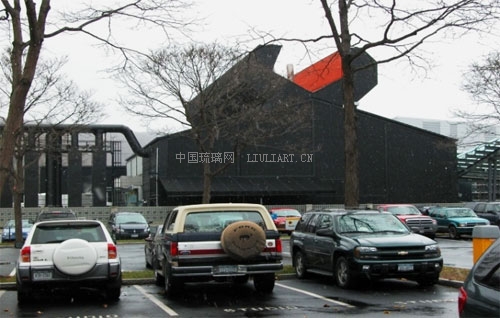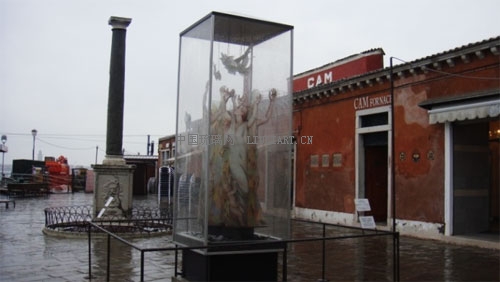在刚结束的2010年ICOM国际博物馆协会第22届大会的委员会分组研讨会“从丝绸之路到集装箱运输——人工制品,环境和文化的传递与变迁”上,上海玻璃博物馆馆长庄小蔚教授向与会者分享了“上海玻璃博物馆:一个中西方文化交流的故事”。
(以下便是庄馆长发言的全文摘录,供大家学习参考。)
自1683年在牛津大学诞生了世界上第一个正式向公众开放的博物馆——阿什莫尔艺术和考古博物馆(Ashmolean Museum of Art and Archaeology) 以来,已经有327年了。

在发达国家每20万人就有一座博物馆,上海有2,000万人口。为此,在2005年上海市政府提出了要建设100所公共博物馆的计划,上海玻璃博物馆就是其中的一个。
我们需要审视自身的角色与目标,以响应中国所出现的戏剧性经济、社会及文化转变:将博物馆的建设过程成为一个思想酝酿的过程,成为思维、感受和行为方式的社会实验,为城市的文化变革开拓道路。
我们的目标是:建设一个具有国际水平的博物馆。用务实工作和想象力,为后工业时代的创意城市注入活力。
世界的财富来自于文化的多样性,来自于专门知识的感受力和形式的多样化。我们认识到相互理解和交流方法的绝妙手段:一个从丝绸之路开始所产生的多元文化 (multi-culture)实践,将帮助我们获得成功。



多元文化是指不同的文化服务于社会发展的文化现象,引起对各方均可受益的文化交流,它是一个跨国界、跨文化的进程。德国设计师Tilman Thürmer和中国馆长领导着一个由德国、法国和中国的专业人员组成的博物馆团队,在一起友好的工作,分享着不同文化的差异带来的创造力,在文字说明、物件选择和感受体验方面,不同文化之间相互尊重和彼此欣赏,从多元的文化视角出发进行设计和审视,以解决大家共同
关心的问题。
在工作过程中,我们鼓励每一个人选择自己的技术侧重点,通过不断质疑,检测自己的想法,并在团队的讨论中,使每一个人了解更多的、来自不同学科的想法,从而拓展了博物馆的设计内容。团队成员来自博物馆学、玻璃艺术学、材料学、建筑学和法律学等不同的学科,研究了玻璃与绘画、雕塑、建筑、音乐、历史、社会学、文化人类学、语言学、宗教、自然科学之间的关系,跨学科研究(cross-subject research)的价值在这里得到了充分的体现。
我们在陈列布置的创造力方面注入了新的观点,并希望从“多元文化”的评判视角找到更广泛的观众。博物馆最吸引让人的地方就是人们可以用另一种方式思考,对历史和文化、材料和运用、艺术和技术产生新的理解。展示是一种空间理念的试验,涉及相关的博物馆学知识、文化表达、教育和记忆的功能、美感的考虑等等。它是一个用舞台展示手法创造的世界,使参观者通过消遣时光的方式来学习知识。
在博物馆的设计中,我们不追求经典意义上的“完整的历史”。事实上,它取材的范围只限于玻璃历史中的一部分,但是它讲述的内容是充满挑战和令人神往的:从埃及的“蜻蜓眼”玻璃珠到中世纪的玻璃镶嵌窗户,从中国古玻璃到现代玻璃雕塑。
我们鼓励并传播这样一种态度:以积极的、好奇的、实验的、颠覆的态度对待文化和物质。事实上,准确考证和大胆想象的态度是同时进行的,这不仅仅指收藏品与历史的关系,也是指观众与作品之间的关系。
我们预留了演讲、培训、研讨的空间,同时还有一个小型的、精致的图书馆,鼓励人们参与、沟通并分享博物馆的知识。
我们将定期组织国际著名学者进行学术交流,更多地传达出多元文化带来的不同文明,这是博物馆的责任。因为我们传达的越多,能够创造的机会也就越多。
博物馆得到了众多专家的支持:
- David Whitehouse,美国康宁玻璃博物馆馆长;
- Susanne Frantz,前美国康宁博物馆策展人;
- Tina Oldknow,美国康宁博物馆策展人;
- Poloma Pastor,国际博物馆协会玻璃专委会主席;
- Karin Rühl,德国Frauenau玻璃博物馆馆长;
- Eva Maria Fahrner–Tutsek,德国Alexander Tutsek-Stiftung文化基金会主席;
- Timothy Close,美国Tacoma玻璃博物馆馆长;
- Dominic Barton,麦肯锡咨询机构主席;
- Andrew Brewerton,英国朴茨茅斯美术学院院长………


我们需要国际社会合作,去大力发展一个充满创意的博物馆。要获取这些成就意味着要努力建设一个旨在开放的和多元的文化交流,要继续加强同国际博物馆协会玻璃专业委员会、美国Corning博物馆、意大利Murano玻璃博物馆、德国现代玻璃博物馆、Frauenau玻璃博物馆、德国Alexander Tutsek-Stiftung基金会、英国Wolverhampton大学和其他一切重要博物馆、大学和企业的双边交流和合作关系。在合作中投入我们的热情和力量,用发现的眼光解读社会。开放,将使我们享受到多元文化带来的在创造力上的贡献。
上海是奢华的和精致的,和其他城市相比,具有更强的戏剧性。人们好像在舞台上表演,希望给人留下印象,他们为自己的位置、立场而奋斗。人们喜欢丰富多彩的活动,并且有很多用词丰富的讨论,它是一座高度文明的城市。
人类的历史就是人类文化日益密切接触的历史。不同文化之间的相互学习和卓有成效的对话是博物馆必须完成的目标,既是与光辉的多种文明的联系,也是为人类社会和谐做出的贡献。
历史没有尽头,中西方文化交流的故事还将继续延续……

(发言稿英文版)
Shanghai Museum of Glass:
A Story of Cultural Interchange between China and the Wes
Professor Zhuang Xiaowei, Director of Shanghai Museum of Glass
It has been 327 years since Ashmolean Museum of Art and Archaeology opened to the public in 1683 in the University of Oxford.
In developed countries, there is a museum for every 200,000 people. Now Shanghai has 20 million people. Therefore, the Shanghai Municipal Government proposed to build 100 public museums in 2005. The Shanghai Museum of Glass is one of these museums.
In response to dramatic changes in the economic, social, and cultural environments in China, we need to examine our own role and objectives. That is to say, we need to make the process of the construction of museums to be a process of intellectual pursuit, to be a social experiment in thinking, feeling, and behavior, and to open the path for the a new "cultural revolution" in Shanghai.
Our mission is to build a museum that meets international standards, using practical work and imagination, to energize the creative city in this post-industrial era. The wealth of the world comes from cultural diversity, expertise, and from diversification. We have recognized the importance of multi-cultural understanding and communication, from the beginnings of Silk Road. This realization is the key to our success.
Multiculturalism refers to the cultural phenomenon which comprises different cultures’ social development, creating culture exchanges which benefit each party. It is a cross-border and a cross-cultural process.
German designer Tilman Thürmer and Chinese curators led a museum team composed of professors from Germany, France and China. They worked together, sharing creativity from different cultures. Regarding aspects of text description, object selection and aesthetic experience, with respect and appreciation between different cultures, the designers addressed common issues of concern.
In the process, we encouraged everyone to choose their own technical focus, to exam their own ideas, and discuss them in a team to get feedback from experts of different disciplines, thereby improving the museum’s design. Team members from different disciplines included curators, glass art, materials science, architecture and law, studied the relationships between glass, painting, sculpture, architecture, music, history, sociology, cultural anthropology, and linguistics. The value of cross-subject research has been fully reflected here.
We used new perspectives in the layout of display, and hope this will attract a greater numbers and a wider multicultural audience.
The top attraction of visiting museums is the opportunity to acquire new understandings of history and culture, usage of materials, art, and technology, and a different way of thinking about things.
Display is a test of spatial concept, which involves relevant museum knowledge, cultural expression, education, memory function, aesthetic considerations, and so on. It is a world created by means of stage display, so that visitors can learn new knowledge in their leisure time.
Regarding the museum's design, we did not pursue the Classical sense of "complete history." Instead, we focused on a part of the history of glass, demonstrating its challenges, ranging from Egypt's "dragonfly eye" glass beads to the medieval glass mosaic windows, and from ancient Chinese glass to modern glass sculptures.
We have encouraged and sought to disseminate an attitude of positiveness, curiosity, and experimentalism towards design. In fact, the attitudes of accurate research and bold imagination are both present. This not only refers to the relationship of history and the collection, but also refers to the relationship between the audience and the works.
We reserved the space for lectures, trainings and seminar, as well as a small, elegant library to encourage people to participate, communicate and share knowledge about the museum. We will organize academic exchanges for internationally renowned scholars regularly to convey different civilizations that highlight cultural diversity. This is the responsibility of the museum. The more we convey, the more chances we have to create.
To facilitating, all kinds of experts are willing to work with us.
- David Whitehouse, Director of the Corning Museum of Glass;
- Susanne Frantz, Former curator of the Corning Museum of Glass, USA;
- Tina Oldknow, Curator of Corning Museum of Glass, USA;
- Poloma Pastor, Director of Glass, the International Council of Museums;
- Karin Rühl, Director of the Frauenau Glass Museum, Germany;
- Eva Maria Fahrner–Tutsek, Chair of the Alexander Tutsek-Stiftung Cultural Development Foundation in Munich, Germany;
- Timothy Close, Director of the Tacoma Glass Museum;
- Dominic Barton, Chairman of McKinsey & Company;
- Andrew Brewerton, Principal of Plymouth College of Art;
………
We need international cooperation to develop a creative museum. To obtain this achievement means to create a communication and collaboration which is to open and multi-cultural, and to continue to strengthen communication and collaboration with the Professional Committee of the International Council of Museums, the United States Corning Museum of Glass Museum of Murano, Italy, Germany Museum of Modern Glass, Frauenau Museum of Glass, Germany Alexander Tutsek-Stiftung Foundation, the UK University of Wolverhampton and other major museums and universities. Openness will enable us to enjoy the contribution of creativity brought by cultural diversity.
Shanghai is luxurious and refined, and is a dynamic city compared with other cities. People seem to act on a stage, hoping to create impressions on others, as they struggle for their positions and their views. People like a variety of activities and rich discussions. It is a highly civilized city.
The history of mankind reflects increasing cross-cultural communication. Mutual learning between different cultures and fruitful dialogues are the goal of museums. They provide the link to a variety of brilliant civilizations and are an important contribution to social harmony.
There's no end to history, and there will be no end to cross-cultural communication between China and the West.
|




